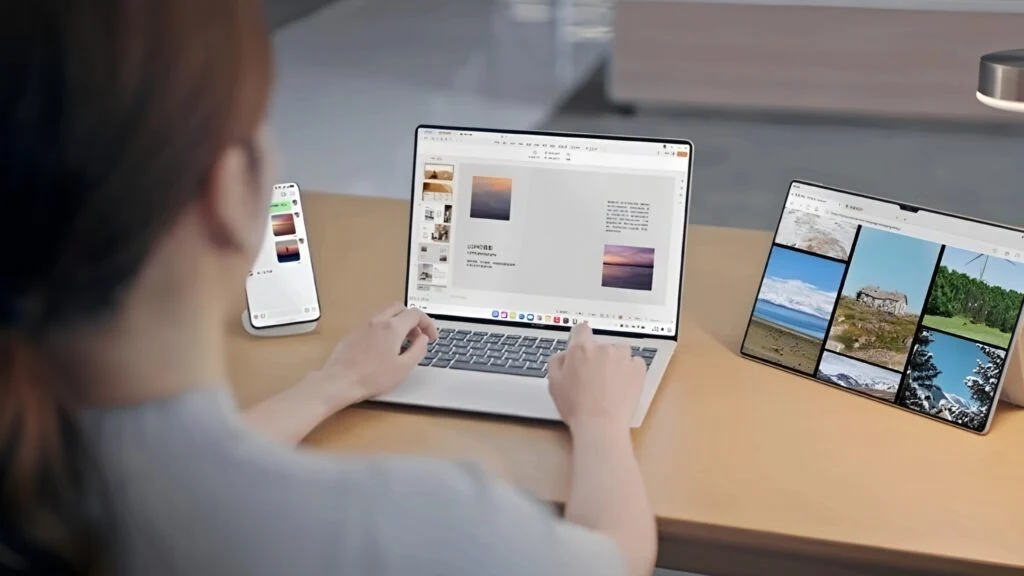Key Takeaways
1. Introduction of HarmonyOS PC: Huawei launches its first personal computer operating system, HarmonyOS PC, to reduce reliance on Western technology.
2. Core Features: Built on HarmonyOS 5, it emphasizes smooth performance, multi-device integration, AI enhancements, and robust security.
3. Comparison with Windows: HarmonyOS PC is tailored for Huawei devices with a cohesive hardware-software relationship, unlike Windows which supports a wide range of hardware.
4. AI Integration: HarmonyOS PC features a deeply integrated AI assistant, Xiaoyi, offering advanced functionalities like real-time summarization and automation.
5. Privacy and Security: The OS includes advanced security measures like full-disk encryption at the chip level, enhancing data security compared to Windows.
Huawei has introduced its first personal computer operating system, named HarmonyOS PC, or Hongmeng Computer in China. This launch marks a significant shift for the company as it seeks to reduce reliance on Western technology. HarmonyOS PC is the result of five years of internal development, involving more than 10,000 engineers and over 2,700 patents.
What is HarmonyOS PC?
HarmonyOS PC is a fully homegrown operating system from Huawei, built upon HarmonyOS 5. It is part of a larger ecosystem that already includes smartphones, tablets, smartwatches, TVs, and even vehicle dashboards. The PC version incorporates HarmonyOS’s core principles, such as smooth performance, multi-device integration, AI enhancements, and robust security into desktop computing.
At the core of the system is a revamped Harmony kernel, backed by the Ark graphics engine and StarShield security framework. Additionally, Huawei provides proprietary development tools like ArkTS and ArkUI. HarmonyOS PC is designed for smooth interaction across various devices, allowing users to easily share keyboards, mice, screens, and files among phones, tablets, and PCs.
Key Features of HarmonyOS PC
The operating system also works closely with Huawei’s AI assistant, Xiaoyi, which facilitates voice commands, smart summarization, translation, and contextual data searches using AI-driven language understanding.
The inaugural HarmonyOS PC is set to be launched on May 19, 2025, and will utilize the Kirin X90 desktop chip, a 10-core processor designed by Huawei. While the device won’t natively support Windows, users can run Windows 11 through the Oseasy virtual machine for added compatibility.
Comparing HarmonyOS PC and Windows
1. Architecture and Ecosystem
Windows is a well-established operating system that offers compatibility across a wide range of hardware and software. In contrast, HarmonyOS PC is tailored specifically for Huawei’s devices and certified accessories, ensuring a more cohesive hardware-software relationship. HarmonyOS comes with over 150 native PC apps and more than 2,000 universal apps, most of which are optimized for Huawei’s devices. Windows, while supporting a vast array of legacy and modern applications, lacks the device-level integration that HarmonyOS aspires to achieve.
2. Multi-Device Collaboration
HarmonyOS PC emphasizes distributed computing, utilizing Huawei’s distributed soft bus technology to allow fluid transitions between devices, like dragging files and using a single keyboard and mouse across multiple screens. Windows has made progress with services such as Phone Link and OneDrive, but it still relies on third-party hardware and applications for more advanced integrations.
3. User Interface and Interaction
In terms of appearance, HarmonyOS PC bears more resemblance to macOS than Windows. It features a bottom-center dock for applications, top status bars, and a sleek, card-based desktop design. The OS includes dynamic wallpapers, motion effects, and gravity-based visuals that give it a contemporary feel. Windows maintains a more traditional layout, although Windows 11 has begun to adopt some visual elements akin to macOS.
Gesture control on HarmonyOS PC is designed to be more intuitive, allowing for three-finger swipes and drag-and-drop multitasking. These elements are crafted with AI in mind and are intricately woven into the system’s functionality.
4. AI Integration
HarmonyOS PC aims to excel in AI integration. Huawei’s Xiaoyi assistant, driven by its Pangu and DeepSeek models, can create templates, translate images, summarize meetings in real-time, and provide system-level automation. In contrast, Windows offers Copilot and Microsoft 365 integrations, but Xiaoyi is more deeply integrated into the OS, allowing it to access system-level commands through voice, image, or text.
5. Privacy and Security
With privacy as a foundational element, Huawei has designed HarmonyOS PC with the StarShield architecture that enforces full-disk encryption at the chip level, ensuring data remains secure even if the drive is removed. Additional features include one-time permission grants, anti-peeping screens, and the ability to wipe the device remotely, even if it’s turned off. Windows provides BitLocker and various user-configurable privacy tools, but it does not offer chip-level full-disk encryption as a default on all devices and relies more on third-party antivirus solutions.
Conclusion
HarmonyOS PC signifies an important step in Huawei’s long-term strategy to reduce dependence on Western technology. While Windows remains the leader in legacy software compatibility and developer support, HarmonyOS PC’s strong integration with Huawei’s ecosystem, advanced AI features, and enhanced security offer a fresh option, especially for users and organizations within China.
Nonetheless, HarmonyOS PC faces hurdles ahead. Development of native apps is ongoing, and it will take time for user habits to adapt, while international adoption may be limited due to geopolitical factors and software compatibility issues. For Huawei, HarmonyOS PC symbolizes more than just an operating system; it is a statement of independence and a significant move toward a unified, cross-device digital future.


Leave a Reply